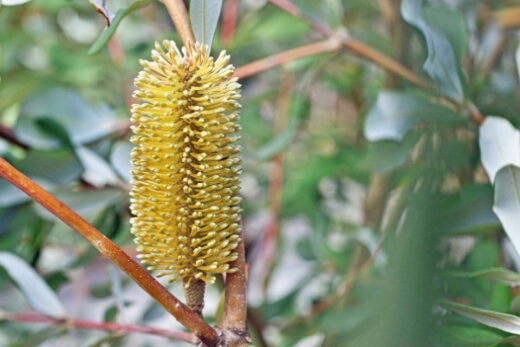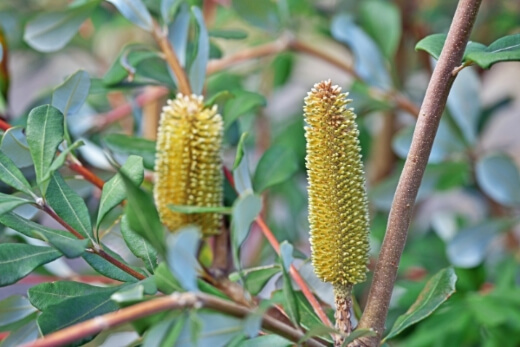Of all the incredible banksias we’ve featured, the Banksia integrifolia, commonly known as coast banksia, is by far one of our favourites. This curious coastal plant is a slow-growing, rugged and versatile species that offers a beautifully bright touch to your garden, almost year-round.
Bold and hardy, they’re a great option for beginner growers or in areas where other plants may not be able to cope with the salty sea spray. From origin, propagation, growth and care, here is everything you need to know.
More...
What is Banksia integrifolia?

The Banksia integrifolia species is one of the best-known Banksia species and grows widely along the coastlines of Victoria and Queensland.
The first of this species was identified by Sir Joseph Banks, who had collected thousands of the banksia specimens to study them more deeply. As he had so many different specimens, one of the main factors in classification had to do with the leaves.
Integrifolia has a Latin origin, Integer meaning ‘entire’ and folium meaning leaf.
Of the Proteaceae family, the Banksia integrifolia is slightly more adaptable than many of its other counterparts. Known to be resistant to salty winds, frost and drought, the integrifolia species has incredibly iconic fruit and nectar-rich blooms.
How to Grow Banksia integrifolia

The Banksia integrifolia species has fantastic dark green, leathery leaves as well as bright, lemon-yellow blooms, which often attract many nectar feeders like birds, bees and butterflies.
This species will flower most of the year, meaning big, bold blooms throughout spring, autumn and winter.
When deciding where to grow your banksia, it’s always best to choose a sunny spot with plenty of well-draining soil. This species is quite used to high acidity, so you won’t have to worry too much about PH levels.
If at all possible, grow your integrifolia near the sea. It will do well with the occasional salty spray.
Are Banksias Fast Growing?
While this particular species is largely slow-growing, B. integrifolia can still reach anywhere between 4 to 15 metres throughout their life cycle.
Although slower than many of the other banksia species, once established, this species does offer distinctive foliage that makes it a great growing choice.
How Long Do Banksias Take to Grow?
When propagated from seed, it can take anywhere between 5 to 6 years for them to reach maturity. While it is absolutely easy to grow, you will need to give it a little extra care in the beginning growing stages.
Once established, however, they will require very little attention.
How to Propagate Coast Banksia Tree

When it comes to propagating banksia, propagation by seed is the safest and easiest method.
Seeds can be collected from wild-growing or garden growing Banksia integrifolia and can be harvested throughout the year.
They will require some pre-treatment before planting to ensure that they germinate. You will need to:
- Remove a seed cone from a healthy, existing plant.
- Place the seed cone into the oven at 120°C for approximately half an hour. Be sure to check it regularly; you don’t want the seed pod to burn or cook.
- The heat will cause the seed pod to open, revealing the individual seeds inside.
- Use a sterilized pair of tweezers to remove each seed.
- Prepare a balanced, vermiculite. Seeding mix into a seeding tray and place seeds directly on top of the soil. Do not cover the seeds with any additional soil.
- Keep the soil moist until germination. It’s important to note that seeds can remain dormant for prolonged periods of time, so you’ll need to be patient.
As banksias are highly prone to fungal infections, it’s a good idea to sterilize your potting mix before sowing.
Once you notice some growth from your seedling, at least one or two leaves, you can transplant it into a bigger pot or straight into the ground.
How to Care for Coast Banksia

The biggest benefit of banksias is that post-propagation won’t require much more attention than occasional watering. Of course, there are other things you can do to add that extra nutritional nudge.
Watering Banksia integrifolia
These plants are drought-tolerant and fungus prone, so dry conditions are far more favourable than wet. Only water once every week or so, and if a very rainy season, omit completely. In the winter months, avoid watering altogether.
Coast Banksia Fertilisation
Overfeeding can lead to more problems than you want, so feeding really shouldn’t be a priority. It’s always a good idea to boost your soil before planting with a good, slow-release fertiliser. If you notice your leaves are starting to wilt, stop feeding.
Pruning Coast Banksia Tree
Pruning is only needed to maintain growth and curb the spread of any major fungal infections. It’s always a good idea to prune back any damaged leaves or spent flowers once the blooming season is over.
Check out our best gardening secateurs for 2024.
Pests, Problems & Diseases
Now, Banksia integrifolia coastal banksia are extremely resilient and hardy as opposed to most other outdoor plants. However, that doesn’t mean you won’t run into an issue or two from time to time.
Pests won’t be your biggest concern, except some caterpillars, perhaps. However, you will need to be on the lookout for any signs of a fungal infection.
Some common conditions include:
- Grey Mould
- Shoot tip blight.
- Bacterial Leaf spot.
- Armillaria Root Rot
- Verticillium wilt
The most detrimental threat to the Banksia integrifolia, though, is a cinnamon fungus or phytophthora cinnamon. Cinnamon dieback is a devastating ecological condition affecting thousands of Australian flora species and causing incredible damage.
If you suspect your plant may have dieback, it’s absolutely essential to remove and destroy that plant before it is able to spread the disease.
Any and all tools or gloves which are used in the removal need to adequately sterilize before using them again.
Banksia integrifolia Frequently Asked Questions
Is banksia fast growing?
Banksia is a fast growing shrub, and great for pots, hedging, or grown as a tree if left to its own devices. In ideal sunny conditions, Banksia will grow 30cm a year, and responds well to pruning to create a bushier shape.
What is the common name for banksias?
Banksia are nearly always just called Banksia, but they are also referred to as white bottlebrush or honeysuckle bushes, though they have no relationship to honeysuckle (lonicera).
Their common names come from a clear resemblance to the flowers of bottlebrush plants, and a sweet, sugary nectar with a fragrance nearly identical to honeysuckle.
How do you propagate Banksia integrifolia?
The best way to propagate Banksia integrifolia is through layering. If you already have a bush in the garden, find a low growing stem and train it down to the ground.
Peg it in place and cover a node with 2 cm of soil. Within a year, it should have rooted and will have new vertical growth.
Does Banksia integrifolia have invasive roots?
Banksia integrifolia does not have invasive roots. The roots of Banksia integrifolia are shallow and will not damage foundations, pools, fences, or lift paving.
If you have a tight space and are looking for a good alternative to Grevillea for hedging, go for Banksia integrifolia.
What is the lifespan of Banksia integrifolia?
Banksia integrifolia are long-lived shrubs, with life expectancies in good conditions of over 100 years, so are a good investment for any garden. Even on poor soil, banksia are tough plants and can cope well with drought, under watering, or overwatering, just don’t leave them in boggy conditions for too long!
Is banksia toxic to humans?
Banksia is not considered toxic and has no toxic effects reported. They are safe to grow in homes with pets and small children, and are completely safe to eat (though like most plants, eating large quantities isn’t advisable).
Is banksia edible?
Banksia has a sweet nectar that can be used in teas, or simply sucked from the flower for a sugar hit. The nectar makes it incredibly attractive to wildlife, and adds a shockingly bountiful honey-like fragrance to your garden.
Can you prune Banksia integrifolia?
You can prune Banksia integrifolia into pretty much any shape you like, but it’s worth taking a little bit of time and effort over it. To create a better, more compact and bushy banksia, prune back three leaves each year, or back to the oldest leaf bud.
That way, you’ll encourage new lateral growth, and a denser overall shape.
Do Banksia integrifolia need a lot of water?
Banksia integrifolia is relatively drought tolerant but should never be left in completely arid ground. Water well in summer, and when trying to establish new plants in the garden.
After planting, water Banksia integrifolia deeply once a fortnight. Once it is showing signs of happy new growth, leave it to the element to toughen up and send out new roots.
Is Banksia integrifolia evergreen?
Banksia integrifolia is an evergreen tree or shrub (depending on pruning and location). It can flower from summer right through to winter, and will only drop its leaves as a result of cold damp winters.
Like most warm-climate plants, cold winters are a challenge, but it is damp winters that are a true threat and will cause leaf drop.
What did the aboriginals use banksia for?
Aboriginals used Banksia to create baskets, weaving the young pliable wood into various useful shapes. The flower cones were used to flavour drinking water too.
Can you grow banksia in pots?
Banksia can be grown in pots, but won’t ever get to its full potential without a hue container. For small yards, a 1-2 ft wide pot will suffice and may also help to keep your Banksia compact for longer.
However, despite having shallow roots, they will need pruning once a year by removing the root ball from the pot and cutting back an inch of root all around to encourage new growth and prevent restriction.

Final Banksia integrifolia Growing Tips
Banksias are known to be able to handle a variety of soil, temperature and moisture conditions, so wherever you choose to grow your Banksia integrifolia, it should handle just fine.
Be sure to keep it in a spot with sufficient sunlight and a well-draining medium.
Keep in mind:
- Integrifolia roots are rugged, so you can grow them in coastal gardens, as border plants or even in pots alongside your patio.
- The blooms and seed pods look great in floral arrangements, so consider cutting a few for your next barbecue.
- Less is more when it comes to banksias, if it seems to be wilt or losing leaves, cut back on watering and feeding.
Discover more of the beauty of Australian native plants with a full range of banksia trees in your garden. Check out our banksia growing guides to help you get started.
Published on January 16, 2023 by Gary Clarke
Last Updated on February 9, 2024




